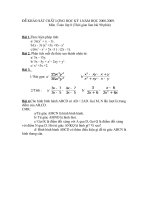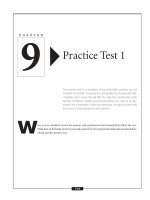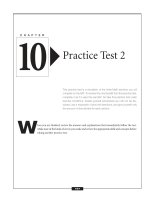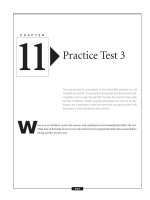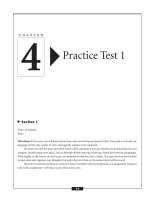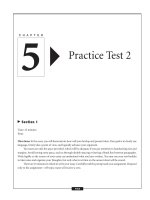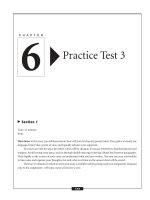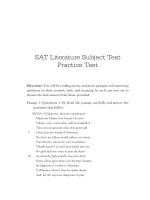My max score SAT world history subject test northeast editing
Bạn đang xem bản rút gọn của tài liệu. Xem và tải ngay bản đầy đủ của tài liệu tại đây (18.87 MB, 333 trang )
Tick…Tick…
Hear that clock ticking? It’s the countdown to the SAT World History
Subject Test, which will be here before you know it. Whether you
have a year to go or just one day, now is the time to start maximizing
your score.
The Test Is Just a Few Months Away!
Don’t worry—you’re still ahead of the game. However, it is important
that you stop delaying and begin preparing now. Follow The Big Picture:
How to Prepare Year-Round (page 195) to make the most of your time
so you’ll be ready on test day. (This section gives you strategies to put
into place up to a year before you actually take the test.)
Actually, I Only Have a Few Weeks!
Even if you’re down to the last few weeks before the test, you still have
plenty of time for a full review. To make the best use of your time, turn
to The Main Course: Comprehensive Strategies and Review (page 39),
where you’ll find Strategies for Multiple-Choice Questions (page 41) to
help you ace the questions. The Diagnosis: How Ready Are You? (page
51) includes a diagnostic test that allows you to identify areas of weakness so that you can address these. You should also review all of World
History Review (page 89) for an overview of the big topics usually covered on the SAT World History Subject Test. As you work through this
information, keep track of those concepts, facts, and ideas that you need
to study. Use the practice tests (beginning on pages 205 and 259) to
increase your comfort with both the format and the content of the test.
Let’s Be Honest. The Test Is Tomorrow
and I’m Freaking Out!
No problem! Review the Introduction (page ix), focusing on About the
Test (page x) and The Essentials: A Last-Minute Study Guide (page 1),
MMS_SATWorldHistory.indd 1
12/28/12 2:38 PM
so you know what to expect when you arrive to take the test and have
some ideas as to how to approach the test questions. Then, take at least
one practice test (beginning on pages 205 and 259). Don’t worry about
your score—just focus on getting familiar with the test. Before you go to
bed, review Quick Test-Taking Tips (page 7) once more. The tips will
walk you through the day ahead.
Finally, relax! Make the most of the tools and resources in this review
guide, and you’ll be ready to earn a top score.
MMS_SATWorldHistory.indd 2
12/28/12 2:38 PM
SAT World History
Subject Test
Maximize Your Score in Less Time
Northeast Editing, Inc.
MMS_SATWorldHistory.indd 3
12/28/12 2:38 PM
Copyright © 2013 by Sourcebooks, Inc.
Cover and internal design © 2013 by Sourcebooks, Inc.
Series cover design by The Book Designers
Cover illustrations by Nick Burns
Cover images © istockphoto.com/jhorrrocks, © Alyn Stafford/Getty Images
Sourcebooks and the colophon are registered trademarks of Sourcebooks, Inc.
All rights reserved. No part of this book may be reproduced in any form or by any electronic or mechanical means including information storage and retrieval systems—except
in the case of brief quotations embodied in critical articles or reviews—without permission in writing from its publisher, Sourcebooks, Inc.
This publication is designed to provide accurate and authoritative information in regard
to the subject matter covered. It is sold with the understanding that the publisher is
not engaged in rendering legal, accounting, or other professional service. If legal advice
or other expert assistance is required, the services of a competent professional person
should be sought.—From a Declaration of Principles Jointly Adopted by a Committee of the
American Bar Association and a Committee of Publishers and Associations
All brand names and product names used in this book are trademarks, registered trademarks, or trade names of their respective holders. Sourcebooks, Inc., is not associated
with any product or vendor in this book.
Published by Sourcebooks, Inc.
P.O. Box 4410, Naperville, Illinois 60567-4410
(630) 961-3900
Fax: (630) 961-2168
www.sourcebooks.com
Library of Congress Cataloging-in-Publication Data
Northeast Editing, Inc.
My max score SAT world history subject test : maximize your score in less time /
Northeast Editing, Inc.
p. cm.
1. World history—Examinations—Study guides. 2. SAT (Educational test)—Study
guides. I. Title.
D21.D44 2013
907.8—dc23
2012037736
Printed and bound in the United States of America.
VP 10 9 8 7 6 5 4 3 2 1
MMS_SATWorldHistory.indd 4
12/28/12 2:38 PM
Also Available in the
My Max Score Series
AP Exam Study Aids
AP Biology
AP Calculus AB/BC
AP English Language and Composition
AP English Literature and Composition
AP European History
AP Statistics
AP U.S. Government and Politics
AP U.S. History
AP World History
SAT Subject Test Study Aids
SAT Biology E/M Subject Test
SAT Literature Subject Test
SAT Math 1 and 2 Subject Test
SAT U.S. History Subject Test
ASVAB Study Aids
ASVAB: Armed Services Vocational Aptitude Battery
MMS_SATWorldHistory.indd 5
12/28/12 2:38 PM
Contents
Introductionix
The Essentials: A Last-Minute Study Guide
Quick Test-Taking Tips
Big Ideas in World History
The Main Course: Comprehensive Strategies and Review
1
7
13
39
Strategies for Multiple-Choice Questions
41
The Diagnosis: How Ready Are You?
51
Diagnostic Test
53
Diagnostic Test Answers and Explanations
72
Using the Diagnostic Test
85
World History Review
89
Review Chapter 1: Prehistory to Early Civilizations
91
Review Chapter 2: The Great Empires
107
Review Chapter 3: The Middle Ages
123
Review Chapter 4: Renaissance, Reformation, and Exploration 139
Review Chapter 5: The Age of Revolutions
151
Review Chapter 6: Industrialization and Imperialism
159
Review Chapter 7: Early Twentieth Century
167
Review Chapter 8: Post–World War II
177
Review Chapter 9: A Globalized World
187
MMS_SATWorldHistory.indd 7
12/28/12 2:38 PM
viii
SAT World History Subject Test
The Big Picture: How to Prepare Year-Round
195
SAT World History Subject Test Practice Test 1
205
Practice Test 1 Answers and Explanations
235
SAT World History Subject Test Practice Test 2
259
Practice Test 2 Answers and Explanations
290
Glossary310
About the Author
MMS_SATWorldHistory.indd 8
320
12/28/12 2:38 PM
Introduction
E
veryone comes to the SAT World History Subject Test from a
different place. For some, it’s the one SAT Subject Test of their
high school career; for others, it’s just one test of many. Some
students have focused on it all year, supplementing their class work
with extra study and practice at home. Other students haven’t been
able to devote the time they would like—perhaps other classes, extracurricular activities, after-school jobs, or family obligations have gotten
in the way. But wherever you’re coming from, this book can help! It’s
been designed to provide maximum assistance no matter where you are
on your study path.
You’ll find that this book has been divided into three sections: a last-
minute study guide to use in the days before the test, a comprehensive
review for those with more than a week to prepare, and a long-term
study plan for students preparing well in advance.
Think of each section as full of suggestions rather than a rigid prescription. Feel free to pick and choose the pieces from each section you
find most helpful. Of course, if you have time, we recommend that you
review everything and take as many practice tests as you can, as many
times as you can.
MMS_SATWorldHistory.indd 9
12/28/12 2:38 PM
x
SAT World History Subject Test
Whether you have a day to cram or a year to study at leisure, here are
some things you should know before diving into the test.
For starters, what is the SAT World History Subject Test, and what
does it cover?
About the Test
The SAT World History Subject Test is an examination used nationally
to assess student readiness for college-level work in history. Some colleges require potential students to take particular SAT subject tests to
qualify either for admission to the school itself or to a particular discipline or major. Some schools may even award college credit if you score
highly on the test. Talk to your school guidance counselor about the
requirements and possibilities for the schools you’re interested in.
The SAT World History Subject Test is designed as a global examination that touches on significant issues and trends in the modern world.
More specifically, it
• Tests your knowledge of basic facts and terms as well as your understanding of basic history and geography
• Examines your knowledge of typical cause-and-effect relationships
throughout history
• Assesses your ability to interpret artistic materials as well as quotations from speeches, documents, and other published matter
• Analyzes your ability to interpret and apply data from maps, charts,
and graphs
The examination takes one hour. During that hour, you’ll answer a
total of ninety-five multiple-choice questions.
What’s Covered
The topics covered on the SAT World History Subject Test break down
as follows:
MMS_SATWorldHistory.indd 10
12/28/12 2:38 PM
xi
INTRODUCTION
Material Covered
Estimated % of Questions
Global or comparative
25%
Europe
25%
Africa
10%
Southwest Asia
10%
South and Southeast Asia
10%
East Asia
10%
Americas (excluding the United States) 10%
Time Period Covered
Estimated % of Questions
Prehistory and civilizations to 500 CE
25%
500 to 1500 CE
25%
1500 to 1900 CE
25%
Post-1900 CE
20%
Cross-chronological
10%
You’ll notice the percentages above sum to 105 percent. Just remember that these are estimated percentages, so they’ll vary slightly on the
actual test.
Note: The SAT World History Subject Test uses BCE (before the
Common Era) and CE (Common Era) as chronological designations
rather than BC (before Christ) and AD (anno Domini), which may be
used in certain world history textbooks.
Test Scoring
As you probably already know, SAT subject tests receive a raw score
that is converted to a point-based score between 200 and 800.
Here is how the raw score is calculated:
1. For each question you answer correctly, you are awarded one
(1) point.
2. For each question you answer incorrectly, you are docked
MMS_SATWorldHistory.indd 11
12/28/12 2:38 PM
xii
SAT World History Subject Test
fractional points. (The amount of fractional points varies depending on the test.) For World History, you lose a quarter of a point
(.25) for each question you answer incorrectly.
3. You do not gain or lose points for questions you do not answer.
4. Once your correct answers are totaled and the fractional points
deducted, your raw score number is produced. If this number is
a fraction, it is rounded up or down accordingly.
5. A complex process called equating is then used to convert the
raw score to a scaled score between 200 and 800 (with 800 being
the highest score available).
Your score shows college admissions staff how well you performed
compared to other students who took the test. For example, the mean
or average score for students who took the SAT World History Subject
Test in 2011 was 607. What does this mean? Well, if you took the test
in 2011 and scored close to a 607, college admissions staff understood
that to mean you scored about as well as half the students who took the
test nationally.
If you haven’t yet taken the test, your goal should be to beat the average score by as high a margin as possible! With this material in hand, you
should feel confident about your ability to do just that. Put the material
in this book to its intended use so you’ll have not only a strong understanding of the key concepts being tested but also ample opportunity to
practice tried-and-true testing strategies.
Beyond the material in this book, we make an additional SAT World
History Subject Test available to you on our website, mymaxscore.com.
That site includes practice tests for other SAT subject tests as well.
Good luck!
MMS_SATWorldHistory.indd 12
12/28/12 2:38 PM
The Essentials:
A Last-M inute
Study Guide
S
o, it’s a night or two before the test and you just don’t feel ready.
Should you panic? Absolutely not! Now is the time to take a deep
breath and finish final preparations. If you’ve been taking a global
history class, studying regularly, and preparing in other ways throughout
the year, you should be just about at your goal. All you need to do is
calm your nerves by breathing deeply, refresh your mind by reviewing a
few key strategies, and get your belongings together for test day. It’s not
too late to maximize your score!
First, remember that being anxious is just a waste of your energy. You
can let your nerves paralyze you, or you can get into a better frame of
mind by focusing your thoughts and energies on the things you can do
now. That approach is more likely to bring you success than worrying
about how nervous you feel. Guide your energy into positive activities
that leave you feeling prepared.
Second, if you’re testing soon, you don’t have a lot of time available, so
it’s important to make the most of the time you do have. Find a location
MMS_SATWorldHistory.indd 1
12/28/12 2:38 PM
2
SAT World History Subject Test
where you have privacy to study in peace, such as your bedroom (good)
or the library (even better, especially if your house is a busy one with a
lot of distractions). Tune out the world by turning off your telephone,
your computer, and all your other electronic gadgets. Stop texting, quit
surfing the Internet, and turn off the music. Ask your family and friends
not to disturb you unless it’s really important. Close your door (or park
yourself in a library cubicle) and get ready.
Getting Ready
Step 1: Review the Test-Taking Tips
Although you’re probably already familiar with the format of this test, if
it’s been a while since you’ve considered the test setup or if you’re just
not sure where to start, take a few minutes to review the first section of
the book (that means you should also go back to the Introduction on
page ix before going forward to Quick Test-Taking Tips on page 7). If
you have only a few days until you test, take time to carefully review
Strategies for Multiple-Choice Questions (page 41). The strategies are
tried and true; they can go far toward giving your score a real boost.
Step 2: Examine the Big Ideas
If you don’t have time for a full content review, at least take the time to
look over the basics. We’ve compiled these for you in Big Ideas in World
History (page 13), which outlines the concepts, themes, and ideas you’ll
encounter in all parts of this test. If you have time, continue on to the
chapter reviews as well.
Step 3: Take a Practice Test
One of the most effective ways to really get to know any test is to take a
practice test, preferably one that has been specifically designed to mimic
the test in question. In this book, you’ll find two complete subject tests
for your use (in addition to the diagnostic test). Plus, a third practice test
is available to you on the mymaxscore.com website at no extra charge.
MMS_SATWorldHistory.indd 2
12/28/12 2:38 PM
THE ESSENTIALS: A LAST-MINUTE STUDY GUIDE
3
When taking practice tests, it’s important to pretend that you’re really
taking the test. That means you should test in a quiet area, avoid looking
at any reference material, and time yourself carefully. Use the answer keys
provided to see how well you’re likely to do if similar questions appear
on the actual test. When reviewing your responses, watch for common
themes or trends and identify the areas in which you can improve. Once
you know where you need the most help, review the appropriate sections
in this book, or go back to your class notes and textbook for more detail.
The Night Before: Gather Your Materials
The last thing you want to do the morning of the test is rush around trying to find everything you need. Therefore, we’ve included a checklist
so that you can make sure you’ve gathered these items together beforehand. Put the checklist items in a backpack or small bag (along with
anything else you think you might need). Have your bag ready so that
you can grab it and go in the morning:
• Your admissions ticket is critical, so pack this first. Place your ticket
in an easy-to-locate side pocket or zippered compartment so you
can get your hands on it quickly when entering the test site.
• You will need photographic proof of identity, so bring your photo
ID. Acceptable photo identification includes your photo driver’s
license, state-issued ID, valid passport, or school ID. You can also
bring a student ID printed on school stationery; see your guidance
counselor if you need this. Store your ID with your admissions ticket.
• Pack several sharpened No. 2 pencils and a no-smudge eraser. Note
that this test is graded entirely by computer, so any smudging can
affect your results. That’s why it’s important to make sure your
erasers won’t leave any marks. Also, note that although there should
be a pencil sharpener available in the testing room, it’s probably not
a bad idea to pack a portable sharpener, just in case. Ink pens are not
acceptable for this test.
• A calculator is not allowed for this test, so don’t bring one.
MMS_SATWorldHistory.indd 3
12/28/12 2:38 PM
4
SAT World History Subject Test
• Plan to wear or bring a watch (a watch, not a phone, as phones aren’t
allowed in the test room) so that you can keep an eye on the clock as
you work. A watch will help you to pace yourself appropriately. Of
course, if your watch has alarms, buzzers, or beepers, turn them off!
• Include a small, easy-to-eat snack. Test day will be long, and you
may need nourishment. Choose a snack that’s high in protein and
low in carbohydrates. Avoid messy items like chocolate bars, as
these can melt onto your hands and desk. Also avoid nuts, as they
can trigger allergies in other testers. Some good choices might be an
energy or protein bar or drink, an easy-to-eat piece of fruit such as
a banana, or some crackers.
• Pack a bottle of water. You’ll want something to drink at some
point, and it’s best to avoid substances with a lot of sugar or caffeine. Although you may think these will give you a boost of energy,
they’re more likely to contribute to test jitters—and you’ll have
enough of those on your own!
• Avoid packing items you can’t take into the testing room. For example, phones, pagers, calculators, and other electronic devices are
prohibited in the testing room for a variety of reasons.
• Here’s one important repeat: pack only what you need:
°° Admissions ticket
°° Photo ID
°° Pencils, eraser, and portable sharpener
°° Watch and/or timer
°° Snack and bottle of water
Test Day: Tips
Here are some other tips for managing test day:
• The night before your test, don’t stay up all night studying. At that
point, you’ll be as ready as ever! Instead, concentrate on getting a
MMS_SATWorldHistory.indd 4
12/28/12 2:38 PM
THE ESSENTIALS: A LAST-MINUTE STUDY GUIDE
5
good night’s sleep. It’s more important to feel rested and alert than
it is to attempt a last-minute cram session.
• Eat a light but satisfying meal in the morning. Protein-rich foods
like eggs, nuts, and yogurt are good choices, as they’ll fill you up
but won’t give you a sugar or caffeine crash later. But don’t eat too
much—you don’t want to be sluggish or uncomfortably full. If you
must have coffee or another caffeinated beverage, that’s fine. Just
try not to overdo it.
• Dress in comfortable layers. The testing room might be hot or cold.
You can’t control the temperature, so you’ll need to be able to
adjust to it. Also, make sure your clothes are comfortable. Your
newest outfit might be fabulous, but the last thing you need during
the test is to feel annoyed by pants that are too tight or irritated by
fabrics that feel itchy.
• Don’t forget your backpack! It has all of your important stuff in it.
• Relax! Once you get to the testing room, take a few deep breaths
and try to channel some of your energy into relaxation. Try blowing into your balled-up fists to rid your body of adrenaline. Remind
yourself that you know the material, you understand how the test
works, and you are ready to go. It’s natural to be nervous, but it’s
better to push that energy into the mental task ahead.
Once the test begins, set everything else in your mind aside and focus
on doing your best. You’ve done all you can to prepare. It’s time to make
that preparation pay off!
MMS_SATWorldHistory.indd 5
12/28/12 2:38 PM
MMS_SATWorldHistory.indd 6
12/28/12 2:38 PM
Quick Test-Taking Tips
T
he SAT World History Subject Test is a multiple-choice test
with ninety-five questions. You’ll have one hour (sixty minutes)
to answer all ninety-five questions. That means you’ll have less
than one minute to read and answer each question. That’s less than one
minute to read and comprehend the question, analyze any associated
chart or other data, and review all five answer options to select the most
appropriate response. Clearly, this test is going to go very quickly. But
don’t worry; you can be successful. You just need to understand how to
approach these questions to maximize your score.
Here’s a tip. The SAT subject tests are intentionally designed to discourage test takers from guessing at answers. If you go back and reread
the Test Scoring section earlier in this guide, you’ll see that test takers
are actually docked a fractional number of points (.25) for answering
incorrectly. That approach is meant to deter you from random guessing
when you don’t know the answer. However, if you think that means
you should never take a guess when you’re unsure of an answer, you’re
wrong! We’re going to recommend that you make guesses—educated
guesses. Read on.
MMS_SATWorldHistory.indd 7
12/28/12 2:38 PM
8
SAT World History Subject Test
Tip 1: Skim the Questions and Answer the Easy Ones
For some timed tests, it doesn’t make sense to skim the questions to find
those that are easier to answer. However, for the SAT subject tests, this
is a valid approach. You’re awarded a raw-score point for every correct
answer, so it’s in your best interest to find the questions that you feel are
“easy” and answer those first.
Tip 2: Don’t Use the Answer Booklet Just Yet
If you’re skimming the test for easy questions, you can waste a lot of precious time locating and recording the answers one by one on your answer
sheet. For example, let’s say you find questions 1, 6, 9, 12, 17, 22, 26,
37, 41, 42, and 57 easy and can answer those right away. How much
time do you think it will then take you to carefully locate the correct
answer lines on the answer sheet to fill in your choices? If you guessed “a
lot!” you’re right about that. Instead of wasting that time checking and
double-checking for the correct answer bubbles, develop a system for
writing directly on the test booklet.
If you’re sure of an answer, write the letter of the correct answer
option clearly in the margin next to the test number. You might want
to circle this letter or put a check mark next to it so that when you later
review your answers to mark them on the answer sheet, you know you
were sure of the answer for this question, and you don’t feel like you
have to waste more time rereading the question.
We’re going to recommend that you mark up your test booklet in
other ways as you work through the test, so make sure you have a clear
system to use beforehand. In general, the simpler this system is, the
easier it will be for you to use. There’s no need to make it complicated.
Tip 3: Answer the Question in Your Head
Read each question or question stem and answer it in your head before
you actually look at any of the answer options. At times, answer choices
MMS_SATWorldHistory.indd 8
12/28/12 2:38 PM
QUICK TEST-TAKING TIPS
9
are written in such a way that they intentionally distract you from the
correct answer. (That’s why they’re called distracters.) However, if you
review the answer options with a good idea of the answer in mind, you’ll
be less confused by other options.
Tip 4: Pay Attention to the Words
As you read the questions and answer choices, pay attention to the wording. Some questions will include words like not or except. The inclusion
of these words radically changes the answer to the question. You’re looking for the answer that is not true or that does not apply. This might seem
obvious, but it’s actually quite easy to overlook these words when you’re
reading quickly.
Other questions might include qualifiers. A qualifier is a word or group
of words that limits or modifies the meaning of another word or group
of words. When a qualifier appears in a question, the correct response
must appropriately reflect that qualifier. For example, a qualifier might
indicate that the correct answer option is the one that is sometimes but
not always true. Some commonly used qualifiers include the following:
• Likely, unlikely
• Apt to, may, might
• Always, never, often, sometimes
• Frequently, probably, usually, seldom
• Some, a few, a majority, many, most, much
In addition, keep an eye out for double negatives, because (just like
in math) two negatives make a positive. For example, not uncommon
actually means “common.” So, for example, if a question asks you to
identify a trend that was “not uncommon” among a certain population,
the question really wants you to find the trend that was common, not
the one that was unique.
MMS_SATWorldHistory.indd 9
12/28/12 2:38 PM
10
SAT World History Subject Test
Tip 5: Read All the Answer Options
Even when you’re pretty sure of your answer, make sure you review all
of the answer options before making your selection. Sometimes more
than one answer may be correct; however, one choice will always be
more correct than the others. In addition, the answer you choose should
completely address all parts of the question and reflect any qualifier that
has been included in the question.
Tip 6: Use Elimination Strategies
The SAT subject tests do penalize you for guessing, but that doesn’t
mean you should avoid making guesses. What you want to make instead
are educated guesses; those are guesses you’ve made after eliminating the
answers you know are wrong. Here’s how to do this:
• Eliminate any answer you know is wrong. Draw a light line through
the answer option in the test booklet.
• Eliminate options that seem unlikely or totally unfamiliar. Circle
or underline the parts of the answer that you feel make it a
wrong choice.
• Eliminate options that don’t seem to fit grammatically with the
stem or question. This is a little trickier, but if an option doesn’t
seem to really fit in with the question, it’s likely wrong. Circle or
underline the part of the answer that seems sketchy.
• Give each answer option the true-false test. That means you should
ask yourself whether the answer option standing alone is true or
false. Eliminate those that are false. The true-false test is useful
when answer options include specific details; false answers would
include misstated facts or faulty reasoning. Circle or underline the
part of the answer that you believe is wrong.
• Watch for the inclusion of absolutes such as all, only, always, or
never. These often signify incorrect responses, because an absolute can make an answer that is sometimes right wrong when the
MMS_SATWorldHistory.indd 10
12/28/12 2:38 PM
QUICK TEST-TAKING TIPS
11
absolute is applied. For example, “The moon is never visible during the day” is wrong because although the moon is usually invisible during the day, there are times when it is visible. Draw a line
through answer options you can eliminate for this reason.
• Look for contradictory paired statements. For example, option A
might read, “The sky is green,” and option B reads, “The sky is blue.”
One of the paired answers is frequently the correct answer.
The more answer choices you eliminate, the better your chances are
of guessing at the correct answer. If you can eliminate at least two or
more of the answer options, you should take a guess.
Once you’re ready to commit to an answer, write the letter of your
answer choice in the margin of the test booklet next to the question
number. Circle it or put a check mark next to it as you did with the
questions you answered easily.
Tip 7: Fill Out the Answer Sheet with Care
Make sure you’re timing yourself as you work through your examination. When you have about ten minutes left, stop what you’re doing
and mark your answers in your answer sheet. You will get credit only
for answers in the answer sheet, so this is a critical step! Make sure you
have enough time to transfer the answers from your booklet to your
answer sheet.
The SAT subject tests are graded completely by computer, so it’s
critical that the answer sheet be kept clean and free from any stray markings. Input your answers carefully, stopping every few questions to make
sure your question and answer numbers correspond before filling in the
oval. Also, be sure you have penciled in the answer space completely and
haven’t left any stray pencil marks in other spaces.
MMS_SATWorldHistory.indd 11
12/28/12 2:38 PM
MMS_SATWorldHistory.indd 12
12/28/12 2:38 PM
Big Ideas in World History
W
orld history is a big topic. As a result, the range of information you’ll have to familiarize yourself with in preparation
for the SAT World History Subject Test is quite expan-
sive and can easily become overwhelming. That’s why it’s important
to know the basics before you get started. To that end, use this section
as a brief guide to some of the major historical topics that frequently
appear on the SAT World History Subject Test. At the very least, be
sure you have a basic understanding of these topics before you attempt
the test.
1. Prehistory to Early Civilizations
According to most scientists, humankind (in its various evolutionary
forms) has been in existence for at least 1.5 million to nearly 2.5 million
years, with hominids having existed for as long as 7 million years. The era
of human existence prior to the dawn of civilization is known as prehistory. Prehistory is typically divided into two eras: the Paleolithic Age and
the Neolithic Age.
The Paleolithic Age stretched from the first appearance of hominids, a humanlike species that was capable of walking upright, to about
8000 BCE. During this period, ancient humans evolved through several
MMS_SATWorldHistory.indd 13
12/28/12 2:38 PM
